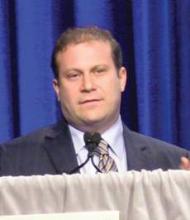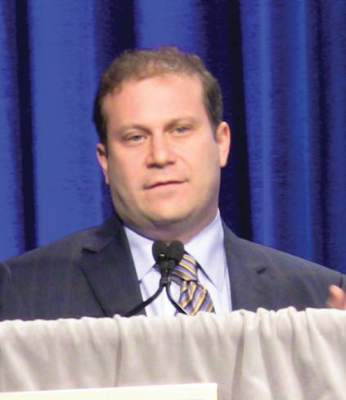User login
Skin Disease Education Foundation (SDEF): Hawaii Dermatology Seminar
VIDEO: PDT Tops Blue-light Therapy for Actinic Keratosis
KAUAI, HAWAII – Using photodynamic therapy in place of blue-light therapy to reverse sun damage such as actinic keratosis is less expensive and associated with fewer adverse events such as pain, according to Dr. Christopher Zachary.
Dr. Zachary, chair of dermatology at the University of California, Irvine, shared his perspectives in a video on the advantages of photodynamic therapy over other field treatments, particularly in an era of changing health care reimbursements.
He spoke at the Hawaii Dermatology Seminar sponsored by Global Academy for Medical Education/Skin Disease Education Foundation. SDEF and this news organization are owned by the same parent company.

KAUAI, HAWAII – Using photodynamic therapy in place of blue-light therapy to reverse sun damage such as actinic keratosis is less expensive and associated with fewer adverse events such as pain, according to Dr. Christopher Zachary.
Dr. Zachary, chair of dermatology at the University of California, Irvine, shared his perspectives in a video on the advantages of photodynamic therapy over other field treatments, particularly in an era of changing health care reimbursements.
He spoke at the Hawaii Dermatology Seminar sponsored by Global Academy for Medical Education/Skin Disease Education Foundation. SDEF and this news organization are owned by the same parent company.

KAUAI, HAWAII – Using photodynamic therapy in place of blue-light therapy to reverse sun damage such as actinic keratosis is less expensive and associated with fewer adverse events such as pain, according to Dr. Christopher Zachary.
Dr. Zachary, chair of dermatology at the University of California, Irvine, shared his perspectives in a video on the advantages of photodynamic therapy over other field treatments, particularly in an era of changing health care reimbursements.
He spoke at the Hawaii Dermatology Seminar sponsored by Global Academy for Medical Education/Skin Disease Education Foundation. SDEF and this news organization are owned by the same parent company.

EXPERT ANALYSIS FROM SDEF HAWAII DERMATOLOGY SEMINAR
VIDEO: PDT tops blue-light therapy for actinic keratosis
KAUAI, HAWAII – Using photodynamic therapy in place of blue-light therapy to reverse sun damage such as actinic keratosis is less expensive and associated with fewer adverse events such as pain, according to Dr. Christopher Zachary.
Dr. Zachary, chair of dermatology at the University of California, Irvine, shared his perspectives in a video on the advantages of photodynamic therapy over other field treatments, particularly in an era of changing health care reimbursements.
He spoke at the Hawaii Dermatology Seminar sponsored by Global Academy for Medical Education/Skin Disease Education Foundation. SDEF and this news organization are owned by the same parent company.
On Twitter @whitneymcknight
KAUAI, HAWAII – Using photodynamic therapy in place of blue-light therapy to reverse sun damage such as actinic keratosis is less expensive and associated with fewer adverse events such as pain, according to Dr. Christopher Zachary.
Dr. Zachary, chair of dermatology at the University of California, Irvine, shared his perspectives in a video on the advantages of photodynamic therapy over other field treatments, particularly in an era of changing health care reimbursements.
He spoke at the Hawaii Dermatology Seminar sponsored by Global Academy for Medical Education/Skin Disease Education Foundation. SDEF and this news organization are owned by the same parent company.
On Twitter @whitneymcknight
KAUAI, HAWAII – Using photodynamic therapy in place of blue-light therapy to reverse sun damage such as actinic keratosis is less expensive and associated with fewer adverse events such as pain, according to Dr. Christopher Zachary.
Dr. Zachary, chair of dermatology at the University of California, Irvine, shared his perspectives in a video on the advantages of photodynamic therapy over other field treatments, particularly in an era of changing health care reimbursements.
He spoke at the Hawaii Dermatology Seminar sponsored by Global Academy for Medical Education/Skin Disease Education Foundation. SDEF and this news organization are owned by the same parent company.
On Twitter @whitneymcknight
EXPERT ANALYSIS FROM SDEF HAWAII DERMATOLOGY SEMINAR
VIDEO: Expert offers tips on buying, using dermatoscopes
KAUAI, HAWAII – If you’re thinking of offering dermoscopy to your patients, which are the best machines for your practice? Are there advantages to having one machine or several? And will you need to do certain kinds of biopsies instead of others?
Dr. David L. Swanson of the Mayo Clinic in Scottsdale, Ariz., was this year’s featured dermoscopy expert at the annual Hawaii Dermatology Seminar sponsored by Global Academy for Medical Education/Skin Disease Education Foundation. He shared his top tips for helping physicians maximize the latest in this technology for the benefit of your patients.
Skin Disease Education Foundation and this news organization are owned by the same parent company.
The video associated with this article is no longer available on this site. Please view all of our videos on the MDedge YouTube channel
On Twitter @whitneymcknight
KAUAI, HAWAII – If you’re thinking of offering dermoscopy to your patients, which are the best machines for your practice? Are there advantages to having one machine or several? And will you need to do certain kinds of biopsies instead of others?
Dr. David L. Swanson of the Mayo Clinic in Scottsdale, Ariz., was this year’s featured dermoscopy expert at the annual Hawaii Dermatology Seminar sponsored by Global Academy for Medical Education/Skin Disease Education Foundation. He shared his top tips for helping physicians maximize the latest in this technology for the benefit of your patients.
Skin Disease Education Foundation and this news organization are owned by the same parent company.
The video associated with this article is no longer available on this site. Please view all of our videos on the MDedge YouTube channel
On Twitter @whitneymcknight
KAUAI, HAWAII – If you’re thinking of offering dermoscopy to your patients, which are the best machines for your practice? Are there advantages to having one machine or several? And will you need to do certain kinds of biopsies instead of others?
Dr. David L. Swanson of the Mayo Clinic in Scottsdale, Ariz., was this year’s featured dermoscopy expert at the annual Hawaii Dermatology Seminar sponsored by Global Academy for Medical Education/Skin Disease Education Foundation. He shared his top tips for helping physicians maximize the latest in this technology for the benefit of your patients.
Skin Disease Education Foundation and this news organization are owned by the same parent company.
The video associated with this article is no longer available on this site. Please view all of our videos on the MDedge YouTube channel
On Twitter @whitneymcknight
EXPERT ANALYSIS FROM THE SDEF HAWAII DERMATOLOGY SEMINAR 2015
VIDEO: When to use glycopyrrolate as first-line hyperhidrosis therapy
KAUAI, HAWAII – When should glycopyrrolate be used as first-line therapy in the treatment of hyperhidrosis? And if it’s not the first treatment, what should take its place?
In a video report from the 2015 Hawaii Dermatology Seminar sponsored by Global Academy for Medical Education/Skin Disease Education Foundation, Dr. Christopher Zachary and Dr. Joshua Spanogle share their thoughts on the latest in hyperhidrosis treatment.
Dr. Zachary disclosed that he has financial relationships with Cutera and Solta. Dr. Spanogle disclosed he has relationships with Illumina and Quantified Skin. SDEF and this news organization are owned by the same parent company.
The video associated with this article is no longer available on this site. Please view all of our videos on the MDedge YouTube channel
On Twitter @whitneymcknight
KAUAI, HAWAII – When should glycopyrrolate be used as first-line therapy in the treatment of hyperhidrosis? And if it’s not the first treatment, what should take its place?
In a video report from the 2015 Hawaii Dermatology Seminar sponsored by Global Academy for Medical Education/Skin Disease Education Foundation, Dr. Christopher Zachary and Dr. Joshua Spanogle share their thoughts on the latest in hyperhidrosis treatment.
Dr. Zachary disclosed that he has financial relationships with Cutera and Solta. Dr. Spanogle disclosed he has relationships with Illumina and Quantified Skin. SDEF and this news organization are owned by the same parent company.
The video associated with this article is no longer available on this site. Please view all of our videos on the MDedge YouTube channel
On Twitter @whitneymcknight
KAUAI, HAWAII – When should glycopyrrolate be used as first-line therapy in the treatment of hyperhidrosis? And if it’s not the first treatment, what should take its place?
In a video report from the 2015 Hawaii Dermatology Seminar sponsored by Global Academy for Medical Education/Skin Disease Education Foundation, Dr. Christopher Zachary and Dr. Joshua Spanogle share their thoughts on the latest in hyperhidrosis treatment.
Dr. Zachary disclosed that he has financial relationships with Cutera and Solta. Dr. Spanogle disclosed he has relationships with Illumina and Quantified Skin. SDEF and this news organization are owned by the same parent company.
The video associated with this article is no longer available on this site. Please view all of our videos on the MDedge YouTube channel
On Twitter @whitneymcknight
AT SDEF HAWAII DERMATOLOGY SEMINAR 2015
VIDEO: Expert tips to avoid eye ptosis
KAUAI, HAWAII– Ptosis can occur if toxins injected around the eyes are imprecisely placed, according to Dr. Brooke Sikora.
In this video report from the Hawaii Dermatology Seminar sponsored by Global Academy for Medical Education/Skin Disease Education Foundation, Dr. Sikora, a private practice dermatologist in Boston discusses how to avoid adverse events when injecting toxins around the lids and brows, and what to do should the procedure not go according to plan.
Dr. Sikora had no relevant financial conflicts to disclose.
SDEF and this news organ
On Twitter @whitneymcknight
KAUAI, HAWAII– Ptosis can occur if toxins injected around the eyes are imprecisely placed, according to Dr. Brooke Sikora.
In this video report from the Hawaii Dermatology Seminar sponsored by Global Academy for Medical Education/Skin Disease Education Foundation, Dr. Sikora, a private practice dermatologist in Boston discusses how to avoid adverse events when injecting toxins around the lids and brows, and what to do should the procedure not go according to plan.
Dr. Sikora had no relevant financial conflicts to disclose.
SDEF and this news organ
On Twitter @whitneymcknight
KAUAI, HAWAII– Ptosis can occur if toxins injected around the eyes are imprecisely placed, according to Dr. Brooke Sikora.
In this video report from the Hawaii Dermatology Seminar sponsored by Global Academy for Medical Education/Skin Disease Education Foundation, Dr. Sikora, a private practice dermatologist in Boston discusses how to avoid adverse events when injecting toxins around the lids and brows, and what to do should the procedure not go according to plan.
Dr. Sikora had no relevant financial conflicts to disclose.
SDEF and this news organ
On Twitter @whitneymcknight
AT SDEF HAWAII DERMATOLOGY SEMINAR
Customizable features enhance the latest fillers
Be prepared for more dermal fillers featuring a mix of low- and high-molecular-weight hyaluronic acid, as well as options for customization, said Dr. Nowell Solish.
Such a combination results in a highly crosslinked product that promotes greater duration with less swelling of the product and improved spreadability, he said at the Hawaii Dermatology Seminar sponsored by Global Academy for Medical Education/Skin Disease Education Foundation.
“There is a role for dermal fillers with these characteristics,” said Dr. Solish of the University of Toronto. He compared the uses of several combination products, including Voluma, Volbella, and Volift.
Dr. Solish’s take on Voluma: “Great for volume,” particularly for the chest and midface, with a low and manageable rate of adverse events.
By contrast, Volbella, which is not yet approved for use in the United States, is a fast-flowing filler suited for lip hydration and perioral lines, rather than volume, he said. In a 2012 study, 48% of 58 adult patients showed an improvement of 1 point or higher on the Lip Fullness Scale at 1 year, based on physician assessment, he said (Clin. Cosmet. Investig. Dermatol. 2012;5;167-72).
Volift, another combination high/low-molecular-weight hyaluronic acid product, is “likely last to get approved” in the United States, Dr. Solish said. The product, however, is “great for marionette lines and smile lines,” as well as for improving the appearance of mild to moderate lines around the face.
Emervel is an example of a product in which the varying particle size allows for customization. The hyaluronic acid concentration of Emervel is consistent, but the product is available in three particle sizes for three depths of injection and varying lifting capacity, he explained.
Finally, the use of a filler containing polymethylmethacrylate (PMMA) microspheres was associated with significant improvements in atrophic facial acne scars, Dr. Solish said, citing a recent randomized controlled trial of 147 subjects (J. Am. Acad. Dermatol. 2014;71:77-83). The microspheres are designed to be consistent is size (30-50 mcm). Treatment-related adverse events were generally mild and transient.
The calcium microsphere filler Radiesse with lidocaine was recently approved by the Food and Drug Administration and should be available soon, he added.
Dr. Solish disclosed serving as an investigator and consultant for Allergan, Medicis, Revance Therapeutics, Marz, and Indeed. SDEF and this news organization are owned by the same parent company.
Be prepared for more dermal fillers featuring a mix of low- and high-molecular-weight hyaluronic acid, as well as options for customization, said Dr. Nowell Solish.
Such a combination results in a highly crosslinked product that promotes greater duration with less swelling of the product and improved spreadability, he said at the Hawaii Dermatology Seminar sponsored by Global Academy for Medical Education/Skin Disease Education Foundation.
“There is a role for dermal fillers with these characteristics,” said Dr. Solish of the University of Toronto. He compared the uses of several combination products, including Voluma, Volbella, and Volift.
Dr. Solish’s take on Voluma: “Great for volume,” particularly for the chest and midface, with a low and manageable rate of adverse events.
By contrast, Volbella, which is not yet approved for use in the United States, is a fast-flowing filler suited for lip hydration and perioral lines, rather than volume, he said. In a 2012 study, 48% of 58 adult patients showed an improvement of 1 point or higher on the Lip Fullness Scale at 1 year, based on physician assessment, he said (Clin. Cosmet. Investig. Dermatol. 2012;5;167-72).
Volift, another combination high/low-molecular-weight hyaluronic acid product, is “likely last to get approved” in the United States, Dr. Solish said. The product, however, is “great for marionette lines and smile lines,” as well as for improving the appearance of mild to moderate lines around the face.
Emervel is an example of a product in which the varying particle size allows for customization. The hyaluronic acid concentration of Emervel is consistent, but the product is available in three particle sizes for three depths of injection and varying lifting capacity, he explained.
Finally, the use of a filler containing polymethylmethacrylate (PMMA) microspheres was associated with significant improvements in atrophic facial acne scars, Dr. Solish said, citing a recent randomized controlled trial of 147 subjects (J. Am. Acad. Dermatol. 2014;71:77-83). The microspheres are designed to be consistent is size (30-50 mcm). Treatment-related adverse events were generally mild and transient.
The calcium microsphere filler Radiesse with lidocaine was recently approved by the Food and Drug Administration and should be available soon, he added.
Dr. Solish disclosed serving as an investigator and consultant for Allergan, Medicis, Revance Therapeutics, Marz, and Indeed. SDEF and this news organization are owned by the same parent company.
Be prepared for more dermal fillers featuring a mix of low- and high-molecular-weight hyaluronic acid, as well as options for customization, said Dr. Nowell Solish.
Such a combination results in a highly crosslinked product that promotes greater duration with less swelling of the product and improved spreadability, he said at the Hawaii Dermatology Seminar sponsored by Global Academy for Medical Education/Skin Disease Education Foundation.
“There is a role for dermal fillers with these characteristics,” said Dr. Solish of the University of Toronto. He compared the uses of several combination products, including Voluma, Volbella, and Volift.
Dr. Solish’s take on Voluma: “Great for volume,” particularly for the chest and midface, with a low and manageable rate of adverse events.
By contrast, Volbella, which is not yet approved for use in the United States, is a fast-flowing filler suited for lip hydration and perioral lines, rather than volume, he said. In a 2012 study, 48% of 58 adult patients showed an improvement of 1 point or higher on the Lip Fullness Scale at 1 year, based on physician assessment, he said (Clin. Cosmet. Investig. Dermatol. 2012;5;167-72).
Volift, another combination high/low-molecular-weight hyaluronic acid product, is “likely last to get approved” in the United States, Dr. Solish said. The product, however, is “great for marionette lines and smile lines,” as well as for improving the appearance of mild to moderate lines around the face.
Emervel is an example of a product in which the varying particle size allows for customization. The hyaluronic acid concentration of Emervel is consistent, but the product is available in three particle sizes for three depths of injection and varying lifting capacity, he explained.
Finally, the use of a filler containing polymethylmethacrylate (PMMA) microspheres was associated with significant improvements in atrophic facial acne scars, Dr. Solish said, citing a recent randomized controlled trial of 147 subjects (J. Am. Acad. Dermatol. 2014;71:77-83). The microspheres are designed to be consistent is size (30-50 mcm). Treatment-related adverse events were generally mild and transient.
The calcium microsphere filler Radiesse with lidocaine was recently approved by the Food and Drug Administration and should be available soon, he added.
Dr. Solish disclosed serving as an investigator and consultant for Allergan, Medicis, Revance Therapeutics, Marz, and Indeed. SDEF and this news organization are owned by the same parent company.
EXPERT ANALYSIS FROM SDEF HAWAII DERMATOLOGY SEMINAR
Careful planning, technique, and counseling can minimize pediatric scarring
It’s a myth that children don’t scar like adults, according to Dr. Jon A. Dyer.
In fact, children often scar worse than adults, he said at the Hawaii Dermatology Seminar sponsored by Global Academy for Medical Education/Skin Disease Education Foundation.
Children have more aggressive healing and inflammatory responses, a highly elastic dermis and connective tissues, and a high activity level that increases the risk of stressing the wound, and they may pay less attention to it, he explained.
Additionally, children can be more difficult to treat for scars because they are often more fearful and anxious, they have a short attention span, and they move around – a lot, he said. This leads to greater anxiety on the part of both the dermatologist and the family, which can lead to rapidly completing a procedure, said Dr. Dyer of the University of Missouri, Columbia.
Successful treatment of a wound or lesion – that is, getting the best initial scar possible – requires good planning, proactive application of surgical principles, and careful patient and family counseling and follow-up, he said.
Among Dr. Dyer’s tips for minimizing scarring when treating lesions in children:
• Do the simplest possible procedure.
• Make the scar as small as possible, keeping in mind that pediatric skin is more elastic.
• Remember that fusiform closures in children do not always require a 3:1 ratio. Tips settle, and divots fill in in young children, he said.
• Operate before puberty when the lesion is located in a cosmetically important area.
Also, consider performing a staged excision if possible; this allows a reduction in final scar length, provides tissue expansion, and allows assessment of individual wound healing. Take as much of the lesion as possible the first time, and remember that central excision is preferable to lateral excision, Dr. Dyer said.
The ideal time to wait between stage 1 and 2 is 4-6 weeks. Longer intervals will lead to more spread and more hypertrophy, and will negate the benefits of staging, he said.
Keep in mind that purse-string sutures can be particularly effective for suturing small spaces and for closing dead spaces, he said, adding that use of a purse-string closure for a round defect can reduce the final scar length by at least 50%.
Scar prevention or minimization requires strict adherence to good surgical principles, Dr. Dyer said, explaining that attention must be paid to perfecting the excision through proper use of skin tension lines, clean wound edges, sharp corners with no or minimal boating, undermining, and removing bulk if necessary.
Track marks are more likely on nonfacial skin and can be avoided by using running subcuticular sutures; in some cases of excellent approximation with no tension, the wound surface can be secured with Dermabond, he said.
Dr. Dyer also outlined the best closure choices for specific areas. For the scalp, use running cuticular sutures; for the extremities, trunk, axilla, or groin, use running subcuticular sutures; for the face, feet, or hands, use interrupted sutures; and for a punch biopsy, consider not using any closure, he advised.
If cuticular stitches are used, minimize scarring by pulling them within 5 days on the face, and within 7-10 days on the body. If dehiscence is a concern, pull the cuticulars and follow with either Dermabond or SteriStrips, he said, but strongly consider using running subcuticular sutures.
Once a wound is closed, secure it with Dermabond or with Steri-Strips and Mastisol and provide protective dressing.
“The bulkier and more colorful the dressing, the happier and more compliant the child,” he said.
Minimize postoperative wound tension in high-risk scars or sites and restrict movement and trauma for as long as possible; 6 weeks is ideal, he added, noting that movement restriction is critical for ensuring a good outcome.
To reduce the trauma of suture removal, “cut ’em long and leave ’em long,” and be sure to use proper scissors, he said.
Running subcuticular suture removal doesn’t hurt; enlist parents’ help in convincing the child of this, he suggested.
Finally, be specific when counseling patients about restrictions, discuss possible complications, provide a written summary including contact numbers, address the scar, and give the follow-up appointment time in writing, he said.
If dehiscence occurs – and it’s not uncommon in children – let it heal and restart the process, he said, noting that prevention is best and can be achieved in many cases with aggressive pre- and postop education, restriction of movement, and proper dressing.
Dr. Dyer stressed that good surgical principles for use in children can also be utilized to improve results in adult patients.
Dr. Dyer reported having no disclosures. SDEF and this new organization are owned by the same parent company.
It’s a myth that children don’t scar like adults, according to Dr. Jon A. Dyer.
In fact, children often scar worse than adults, he said at the Hawaii Dermatology Seminar sponsored by Global Academy for Medical Education/Skin Disease Education Foundation.
Children have more aggressive healing and inflammatory responses, a highly elastic dermis and connective tissues, and a high activity level that increases the risk of stressing the wound, and they may pay less attention to it, he explained.
Additionally, children can be more difficult to treat for scars because they are often more fearful and anxious, they have a short attention span, and they move around – a lot, he said. This leads to greater anxiety on the part of both the dermatologist and the family, which can lead to rapidly completing a procedure, said Dr. Dyer of the University of Missouri, Columbia.
Successful treatment of a wound or lesion – that is, getting the best initial scar possible – requires good planning, proactive application of surgical principles, and careful patient and family counseling and follow-up, he said.
Among Dr. Dyer’s tips for minimizing scarring when treating lesions in children:
• Do the simplest possible procedure.
• Make the scar as small as possible, keeping in mind that pediatric skin is more elastic.
• Remember that fusiform closures in children do not always require a 3:1 ratio. Tips settle, and divots fill in in young children, he said.
• Operate before puberty when the lesion is located in a cosmetically important area.
Also, consider performing a staged excision if possible; this allows a reduction in final scar length, provides tissue expansion, and allows assessment of individual wound healing. Take as much of the lesion as possible the first time, and remember that central excision is preferable to lateral excision, Dr. Dyer said.
The ideal time to wait between stage 1 and 2 is 4-6 weeks. Longer intervals will lead to more spread and more hypertrophy, and will negate the benefits of staging, he said.
Keep in mind that purse-string sutures can be particularly effective for suturing small spaces and for closing dead spaces, he said, adding that use of a purse-string closure for a round defect can reduce the final scar length by at least 50%.
Scar prevention or minimization requires strict adherence to good surgical principles, Dr. Dyer said, explaining that attention must be paid to perfecting the excision through proper use of skin tension lines, clean wound edges, sharp corners with no or minimal boating, undermining, and removing bulk if necessary.
Track marks are more likely on nonfacial skin and can be avoided by using running subcuticular sutures; in some cases of excellent approximation with no tension, the wound surface can be secured with Dermabond, he said.
Dr. Dyer also outlined the best closure choices for specific areas. For the scalp, use running cuticular sutures; for the extremities, trunk, axilla, or groin, use running subcuticular sutures; for the face, feet, or hands, use interrupted sutures; and for a punch biopsy, consider not using any closure, he advised.
If cuticular stitches are used, minimize scarring by pulling them within 5 days on the face, and within 7-10 days on the body. If dehiscence is a concern, pull the cuticulars and follow with either Dermabond or SteriStrips, he said, but strongly consider using running subcuticular sutures.
Once a wound is closed, secure it with Dermabond or with Steri-Strips and Mastisol and provide protective dressing.
“The bulkier and more colorful the dressing, the happier and more compliant the child,” he said.
Minimize postoperative wound tension in high-risk scars or sites and restrict movement and trauma for as long as possible; 6 weeks is ideal, he added, noting that movement restriction is critical for ensuring a good outcome.
To reduce the trauma of suture removal, “cut ’em long and leave ’em long,” and be sure to use proper scissors, he said.
Running subcuticular suture removal doesn’t hurt; enlist parents’ help in convincing the child of this, he suggested.
Finally, be specific when counseling patients about restrictions, discuss possible complications, provide a written summary including contact numbers, address the scar, and give the follow-up appointment time in writing, he said.
If dehiscence occurs – and it’s not uncommon in children – let it heal and restart the process, he said, noting that prevention is best and can be achieved in many cases with aggressive pre- and postop education, restriction of movement, and proper dressing.
Dr. Dyer stressed that good surgical principles for use in children can also be utilized to improve results in adult patients.
Dr. Dyer reported having no disclosures. SDEF and this new organization are owned by the same parent company.
It’s a myth that children don’t scar like adults, according to Dr. Jon A. Dyer.
In fact, children often scar worse than adults, he said at the Hawaii Dermatology Seminar sponsored by Global Academy for Medical Education/Skin Disease Education Foundation.
Children have more aggressive healing and inflammatory responses, a highly elastic dermis and connective tissues, and a high activity level that increases the risk of stressing the wound, and they may pay less attention to it, he explained.
Additionally, children can be more difficult to treat for scars because they are often more fearful and anxious, they have a short attention span, and they move around – a lot, he said. This leads to greater anxiety on the part of both the dermatologist and the family, which can lead to rapidly completing a procedure, said Dr. Dyer of the University of Missouri, Columbia.
Successful treatment of a wound or lesion – that is, getting the best initial scar possible – requires good planning, proactive application of surgical principles, and careful patient and family counseling and follow-up, he said.
Among Dr. Dyer’s tips for minimizing scarring when treating lesions in children:
• Do the simplest possible procedure.
• Make the scar as small as possible, keeping in mind that pediatric skin is more elastic.
• Remember that fusiform closures in children do not always require a 3:1 ratio. Tips settle, and divots fill in in young children, he said.
• Operate before puberty when the lesion is located in a cosmetically important area.
Also, consider performing a staged excision if possible; this allows a reduction in final scar length, provides tissue expansion, and allows assessment of individual wound healing. Take as much of the lesion as possible the first time, and remember that central excision is preferable to lateral excision, Dr. Dyer said.
The ideal time to wait between stage 1 and 2 is 4-6 weeks. Longer intervals will lead to more spread and more hypertrophy, and will negate the benefits of staging, he said.
Keep in mind that purse-string sutures can be particularly effective for suturing small spaces and for closing dead spaces, he said, adding that use of a purse-string closure for a round defect can reduce the final scar length by at least 50%.
Scar prevention or minimization requires strict adherence to good surgical principles, Dr. Dyer said, explaining that attention must be paid to perfecting the excision through proper use of skin tension lines, clean wound edges, sharp corners with no or minimal boating, undermining, and removing bulk if necessary.
Track marks are more likely on nonfacial skin and can be avoided by using running subcuticular sutures; in some cases of excellent approximation with no tension, the wound surface can be secured with Dermabond, he said.
Dr. Dyer also outlined the best closure choices for specific areas. For the scalp, use running cuticular sutures; for the extremities, trunk, axilla, or groin, use running subcuticular sutures; for the face, feet, or hands, use interrupted sutures; and for a punch biopsy, consider not using any closure, he advised.
If cuticular stitches are used, minimize scarring by pulling them within 5 days on the face, and within 7-10 days on the body. If dehiscence is a concern, pull the cuticulars and follow with either Dermabond or SteriStrips, he said, but strongly consider using running subcuticular sutures.
Once a wound is closed, secure it with Dermabond or with Steri-Strips and Mastisol and provide protective dressing.
“The bulkier and more colorful the dressing, the happier and more compliant the child,” he said.
Minimize postoperative wound tension in high-risk scars or sites and restrict movement and trauma for as long as possible; 6 weeks is ideal, he added, noting that movement restriction is critical for ensuring a good outcome.
To reduce the trauma of suture removal, “cut ’em long and leave ’em long,” and be sure to use proper scissors, he said.
Running subcuticular suture removal doesn’t hurt; enlist parents’ help in convincing the child of this, he suggested.
Finally, be specific when counseling patients about restrictions, discuss possible complications, provide a written summary including contact numbers, address the scar, and give the follow-up appointment time in writing, he said.
If dehiscence occurs – and it’s not uncommon in children – let it heal and restart the process, he said, noting that prevention is best and can be achieved in many cases with aggressive pre- and postop education, restriction of movement, and proper dressing.
Dr. Dyer stressed that good surgical principles for use in children can also be utilized to improve results in adult patients.
Dr. Dyer reported having no disclosures. SDEF and this new organization are owned by the same parent company.
VIDEO: Best practices for antibiotic use in acne
KAUAI, HAWAII – Should you taper or stop your acne patient’s oral antibiotic abruptly? And what are the best topical and oral antibiotics to treat chronic acne? Dr. Linda Stein Gold of the Henry Ford Hospital in Detroit addresses these concerns and discusses the latest developments in topical antibiotics at the Hawaii Dermatology Seminar sponsored by Global Academy for Medical Education/Skin Disease Education Foundation. Dr. Gold disclosed she has several industry ties, including with Galderma, Roche, and Stiefel. SDEF and this news organization are owed by the same parent company.
On Twitter @whitneymcknight
KAUAI, HAWAII – Should you taper or stop your acne patient’s oral antibiotic abruptly? And what are the best topical and oral antibiotics to treat chronic acne? Dr. Linda Stein Gold of the Henry Ford Hospital in Detroit addresses these concerns and discusses the latest developments in topical antibiotics at the Hawaii Dermatology Seminar sponsored by Global Academy for Medical Education/Skin Disease Education Foundation. Dr. Gold disclosed she has several industry ties, including with Galderma, Roche, and Stiefel. SDEF and this news organization are owed by the same parent company.
On Twitter @whitneymcknight
KAUAI, HAWAII – Should you taper or stop your acne patient’s oral antibiotic abruptly? And what are the best topical and oral antibiotics to treat chronic acne? Dr. Linda Stein Gold of the Henry Ford Hospital in Detroit addresses these concerns and discusses the latest developments in topical antibiotics at the Hawaii Dermatology Seminar sponsored by Global Academy for Medical Education/Skin Disease Education Foundation. Dr. Gold disclosed she has several industry ties, including with Galderma, Roche, and Stiefel. SDEF and this news organization are owed by the same parent company.
On Twitter @whitneymcknight
AT SDEF HAWAII DERMATOLOGY SEMINAR
VIDEO: Secukinumab ‘exciting’ new agent for psoriasis
KAUAI, HAWAII – The Food and Drug administration recently approved a new class of drug for psoriasis. Secukinumab, indicated for the treatment of mild to severe psoriasis, targets IL-17, a cytokine highly implicated in the disease.
“I’m very excited to try this drug in my patients,” Dr. Kristina Callis Duffin said at the Hawaii Dermatology Seminar sponsored by Global Academy for Medical Education/Skin Disease Education Foundation.
In this report, Dr. Duffin of the University of Utah explains the drug’s mechanism of action, describes how it differs from other biologic agents used to treat psoriasis, and shares promising data showing improved scores on the Psoriasis Area and Severity Index (PASI).
SDEF and this news organization are owned by the same parent company.
The video associated with this article is no longer available on this site. Please view all of our videos on the MDedge YouTube channel
On Twitter @whitneymcknight
KAUAI, HAWAII – The Food and Drug administration recently approved a new class of drug for psoriasis. Secukinumab, indicated for the treatment of mild to severe psoriasis, targets IL-17, a cytokine highly implicated in the disease.
“I’m very excited to try this drug in my patients,” Dr. Kristina Callis Duffin said at the Hawaii Dermatology Seminar sponsored by Global Academy for Medical Education/Skin Disease Education Foundation.
In this report, Dr. Duffin of the University of Utah explains the drug’s mechanism of action, describes how it differs from other biologic agents used to treat psoriasis, and shares promising data showing improved scores on the Psoriasis Area and Severity Index (PASI).
SDEF and this news organization are owned by the same parent company.
The video associated with this article is no longer available on this site. Please view all of our videos on the MDedge YouTube channel
On Twitter @whitneymcknight
KAUAI, HAWAII – The Food and Drug administration recently approved a new class of drug for psoriasis. Secukinumab, indicated for the treatment of mild to severe psoriasis, targets IL-17, a cytokine highly implicated in the disease.
“I’m very excited to try this drug in my patients,” Dr. Kristina Callis Duffin said at the Hawaii Dermatology Seminar sponsored by Global Academy for Medical Education/Skin Disease Education Foundation.
In this report, Dr. Duffin of the University of Utah explains the drug’s mechanism of action, describes how it differs from other biologic agents used to treat psoriasis, and shares promising data showing improved scores on the Psoriasis Area and Severity Index (PASI).
SDEF and this news organization are owned by the same parent company.
The video associated with this article is no longer available on this site. Please view all of our videos on the MDedge YouTube channel
On Twitter @whitneymcknight
AT SDEF HAWAII DERMATOLOGY SEMINAR
Consider off-label immunosuppressants for refractory urticaria
KAUAI, HAWAII – Don’t waste your time on “yet another antihistamine” when first- and second-line therapies fail for refractory urticaria.
That’s what Dr. Joseph Eastern advised physicians at the annual Hawaii Dermatology Seminar sponsored by Global Academy for Medical Education/Skin Disease Education Foundation.
“There is just not enough evidence to support using antihistamines and playing roulette with your patient’s health,” Dr. Eastern said, noting that the degree of disability, both socially and occupationally, that accompanies chronic urticaria is on par with that of a patient awaiting triple coronary bypass.
Also not on Dr. Eastern’s list of go-to treatments for the condition are thyroxine replacement, special diets, or anti-Helicobacter pylori treatment, despite some in the field who believe there is an overlap in the pathogenesis of urticaria and this gastrointestinal infection. “None of these are supported by credible evidence,” Dr. Eastern, a dermatologist in private practice in Belleville, N.J., said in an interview.
Once second-line therapies such as doxepin, leukotriene antagonists, corticosteroids, dapsone, sulfasalzine, and even narrow-band UVB are exhausted, Dr. Eastern suggested using off-label immunosuppressants for chronic urticaria as third-line treatment. He discussed three in particular:
• Cyclosporine. At least three randomized controlled trials support the safety and efficacy of cyclosporine in chronic urticaria. Dr. Eastern noted that, in a 2011 study, the drug was particularly effective in chronic urticaria that had shorter duration of disease and a CU (chronic urticaria) index of 10 or less (Ann. Allergy Asthma Immunol. 2011;107:523-8).
The most effective dosing seems to be between 3 mg/kg per day and 6 mg/kg per day, given over the course of 2-3 months (Br. J. Dermatol. 2000;143:365-72). Approximately 80% of patients responded well to treatment (J. Dermatol. 2008;35:276-82). Of those, one-third experienced complete remission of symptoms, another third experienced mild relapse, and one-third relapsed more severely. Dr. Eastern noted that long-term use of cyclosporine is associated with risks of hypertension and renal impairment.
• Methotrexate. Although there are no randomized controlled studies to support the use of methotrexate for chronic urticaria, there have been reported anecdotal successes, Dr. Eastern said. The benefits seem to be in the drug’s anti-inflammatory and immunosuppressive effects (Br. J. Dermatol. 2010;162:191-4).
“Methotrexate may be of benefit independently of the pathogenic mechanism of urticaria and is a viable option in situations where the cost of therapy is a significant concern,” he said in the interview.
• Omalizumab. This recombinant humanized monoclonal antibody, which selectively binds to, and lowers, serum IgE, is “the new kid on the block,” Dr. Eastern said. “The results are impressive, particularly in patients with demonstrable autoantibodies to IgE, but insurance approval is often difficult to obtain, due to the drug’s expense.”
Two other treatments clinicians could consider are high-dose intravenous immunoglobulin (0.4 g/kg for 5 days) and plasmapheresis, according to Dr. Eastern. The former’s mechanism of action is unclear at this point, but in patients with severe, unremitting chronic urticaria, plasmapheresis was shown to eliminate the functional autoantibodies, favoring a pathogenic role.
When all else fails, Dr. Eastern urged physicians to reconsider the diagnosis.
“The presence of systemic symptoms could mean the urticarial rash is not ordinary urticaria,” he said, suggesting that vasculitis, Schitzler’s syndrome, adult-onset Still’s disease, an autoinflammatory syndrome, or urticarial dermatitis could be at play.
Dr. Eastern disclosed that he serves as a consultant to Genentech, which markets omalizumab as Xolair.
SDEF and this news organization are owned by the same parent company.
On Twitter @whitneymcknight
KAUAI, HAWAII – Don’t waste your time on “yet another antihistamine” when first- and second-line therapies fail for refractory urticaria.
That’s what Dr. Joseph Eastern advised physicians at the annual Hawaii Dermatology Seminar sponsored by Global Academy for Medical Education/Skin Disease Education Foundation.
“There is just not enough evidence to support using antihistamines and playing roulette with your patient’s health,” Dr. Eastern said, noting that the degree of disability, both socially and occupationally, that accompanies chronic urticaria is on par with that of a patient awaiting triple coronary bypass.
Also not on Dr. Eastern’s list of go-to treatments for the condition are thyroxine replacement, special diets, or anti-Helicobacter pylori treatment, despite some in the field who believe there is an overlap in the pathogenesis of urticaria and this gastrointestinal infection. “None of these are supported by credible evidence,” Dr. Eastern, a dermatologist in private practice in Belleville, N.J., said in an interview.
Once second-line therapies such as doxepin, leukotriene antagonists, corticosteroids, dapsone, sulfasalzine, and even narrow-band UVB are exhausted, Dr. Eastern suggested using off-label immunosuppressants for chronic urticaria as third-line treatment. He discussed three in particular:
• Cyclosporine. At least three randomized controlled trials support the safety and efficacy of cyclosporine in chronic urticaria. Dr. Eastern noted that, in a 2011 study, the drug was particularly effective in chronic urticaria that had shorter duration of disease and a CU (chronic urticaria) index of 10 or less (Ann. Allergy Asthma Immunol. 2011;107:523-8).
The most effective dosing seems to be between 3 mg/kg per day and 6 mg/kg per day, given over the course of 2-3 months (Br. J. Dermatol. 2000;143:365-72). Approximately 80% of patients responded well to treatment (J. Dermatol. 2008;35:276-82). Of those, one-third experienced complete remission of symptoms, another third experienced mild relapse, and one-third relapsed more severely. Dr. Eastern noted that long-term use of cyclosporine is associated with risks of hypertension and renal impairment.
• Methotrexate. Although there are no randomized controlled studies to support the use of methotrexate for chronic urticaria, there have been reported anecdotal successes, Dr. Eastern said. The benefits seem to be in the drug’s anti-inflammatory and immunosuppressive effects (Br. J. Dermatol. 2010;162:191-4).
“Methotrexate may be of benefit independently of the pathogenic mechanism of urticaria and is a viable option in situations where the cost of therapy is a significant concern,” he said in the interview.
• Omalizumab. This recombinant humanized monoclonal antibody, which selectively binds to, and lowers, serum IgE, is “the new kid on the block,” Dr. Eastern said. “The results are impressive, particularly in patients with demonstrable autoantibodies to IgE, but insurance approval is often difficult to obtain, due to the drug’s expense.”
Two other treatments clinicians could consider are high-dose intravenous immunoglobulin (0.4 g/kg for 5 days) and plasmapheresis, according to Dr. Eastern. The former’s mechanism of action is unclear at this point, but in patients with severe, unremitting chronic urticaria, plasmapheresis was shown to eliminate the functional autoantibodies, favoring a pathogenic role.
When all else fails, Dr. Eastern urged physicians to reconsider the diagnosis.
“The presence of systemic symptoms could mean the urticarial rash is not ordinary urticaria,” he said, suggesting that vasculitis, Schitzler’s syndrome, adult-onset Still’s disease, an autoinflammatory syndrome, or urticarial dermatitis could be at play.
Dr. Eastern disclosed that he serves as a consultant to Genentech, which markets omalizumab as Xolair.
SDEF and this news organization are owned by the same parent company.
On Twitter @whitneymcknight
KAUAI, HAWAII – Don’t waste your time on “yet another antihistamine” when first- and second-line therapies fail for refractory urticaria.
That’s what Dr. Joseph Eastern advised physicians at the annual Hawaii Dermatology Seminar sponsored by Global Academy for Medical Education/Skin Disease Education Foundation.
“There is just not enough evidence to support using antihistamines and playing roulette with your patient’s health,” Dr. Eastern said, noting that the degree of disability, both socially and occupationally, that accompanies chronic urticaria is on par with that of a patient awaiting triple coronary bypass.
Also not on Dr. Eastern’s list of go-to treatments for the condition are thyroxine replacement, special diets, or anti-Helicobacter pylori treatment, despite some in the field who believe there is an overlap in the pathogenesis of urticaria and this gastrointestinal infection. “None of these are supported by credible evidence,” Dr. Eastern, a dermatologist in private practice in Belleville, N.J., said in an interview.
Once second-line therapies such as doxepin, leukotriene antagonists, corticosteroids, dapsone, sulfasalzine, and even narrow-band UVB are exhausted, Dr. Eastern suggested using off-label immunosuppressants for chronic urticaria as third-line treatment. He discussed three in particular:
• Cyclosporine. At least three randomized controlled trials support the safety and efficacy of cyclosporine in chronic urticaria. Dr. Eastern noted that, in a 2011 study, the drug was particularly effective in chronic urticaria that had shorter duration of disease and a CU (chronic urticaria) index of 10 or less (Ann. Allergy Asthma Immunol. 2011;107:523-8).
The most effective dosing seems to be between 3 mg/kg per day and 6 mg/kg per day, given over the course of 2-3 months (Br. J. Dermatol. 2000;143:365-72). Approximately 80% of patients responded well to treatment (J. Dermatol. 2008;35:276-82). Of those, one-third experienced complete remission of symptoms, another third experienced mild relapse, and one-third relapsed more severely. Dr. Eastern noted that long-term use of cyclosporine is associated with risks of hypertension and renal impairment.
• Methotrexate. Although there are no randomized controlled studies to support the use of methotrexate for chronic urticaria, there have been reported anecdotal successes, Dr. Eastern said. The benefits seem to be in the drug’s anti-inflammatory and immunosuppressive effects (Br. J. Dermatol. 2010;162:191-4).
“Methotrexate may be of benefit independently of the pathogenic mechanism of urticaria and is a viable option in situations where the cost of therapy is a significant concern,” he said in the interview.
• Omalizumab. This recombinant humanized monoclonal antibody, which selectively binds to, and lowers, serum IgE, is “the new kid on the block,” Dr. Eastern said. “The results are impressive, particularly in patients with demonstrable autoantibodies to IgE, but insurance approval is often difficult to obtain, due to the drug’s expense.”
Two other treatments clinicians could consider are high-dose intravenous immunoglobulin (0.4 g/kg for 5 days) and plasmapheresis, according to Dr. Eastern. The former’s mechanism of action is unclear at this point, but in patients with severe, unremitting chronic urticaria, plasmapheresis was shown to eliminate the functional autoantibodies, favoring a pathogenic role.
When all else fails, Dr. Eastern urged physicians to reconsider the diagnosis.
“The presence of systemic symptoms could mean the urticarial rash is not ordinary urticaria,” he said, suggesting that vasculitis, Schitzler’s syndrome, adult-onset Still’s disease, an autoinflammatory syndrome, or urticarial dermatitis could be at play.
Dr. Eastern disclosed that he serves as a consultant to Genentech, which markets omalizumab as Xolair.
SDEF and this news organization are owned by the same parent company.
On Twitter @whitneymcknight
EXPERT ANALYSIS FROM SDEF HAWAII DERMATOLOGY SEMINAR








